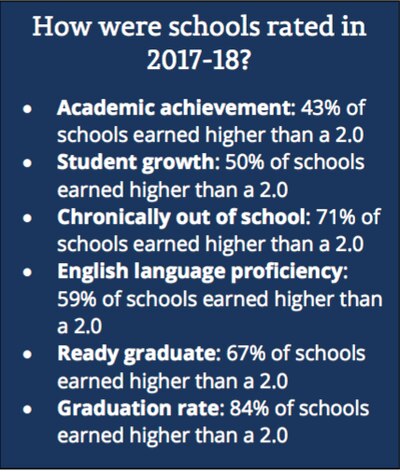For the first time, Tennessee families can look up how their neighborhood school is rated when it comes to academic achievement and growth, how often kids are missing school, and whether English learners are making progress learning the language.
A revamped state report card, released on Tuesday online, also rates high schools for their graduation rates and student readiness for college.
Tennessee’s education department has generated a statewide snapshot for years but, under the requirements of a new federal law, the expanded report card improves transparency about the quality of the state’s 1,800-plus public schools and 146 districts.
Using a scale of 0 to 4 with 4 being the highest, the rating system is designed to give parents and communities a fuller picture beyond just state test scores of how their school is doing. However, those results are still available too, along with updates on funding per pupil and demographics of student population within schools and districts.
“We want families to have easy access to information about their school’s performance and how it is meeting the needs of all students, and we want them to have that context on a variety of metrics that encompass success,” Education Commissioner Candice McQueen said in a statement.
The redesign was developed with the help of feedback from educators, parents, and community organizations.
The new tool includes additional new data on the performance of different student groups — black, Hispanic, or Native American students, students from low-income families, English learners, and students with disabilities. There’s also a Spanish translation of the material.
Ratings on each of six performance indicators are based on how well each school is doing overall or how much it improved over the last year, defaulting to the higher of the two ratings. By including student growth as a measure, the state is taking into account kids who are further behind for reasons they can’t necessarily control, such as poverty and fewer resources.

“The information and ratings on the report card are intended to be a catalyst for conversation, not a defining characteristic,” according to an information sheet explaining how the ratings work. “Ultimately, a quality education is more than a score, and these ratings provide one perspective on how a school is performing.”
State officials are encouraging parents to contact their principal or district leader with questions about their school’s ratings. And bracing for a potential flood of calls, the department has provided district leaders with talking points.
The first message suggests: “Our students are seeing success — with graduation rates, ACT scores, and college-going rates on the rise — but there is still more work to do to ensure that every school serves every student well. Parents and community members need easy-to-understand information about their schools to support this progress.”
On a conference call with reporters, McQueen said she is hopeful that the new information can help school communities strategize about how to get better, especially if some student groups aren’t performing well.
“These [ratings] aren’t destiny, but are providing information for how we can improve,” she said.
Two years in the making, the rating system garnered mostly positive reviews while under development, but is not as user-friendly as initially planned.
The state was planning to assign A-F grades to schools and districts, but had to drop that approach last spring after the legislature passed emergency laws to address another year of problems while giving the state’s TNReady test. Lawmakers ordered that no school could receive letter grades based on this year’s test results, sending the education department back to the drawing board on how to comply with federal and state laws.
The numeric system is the result, and the state also dropped plans to give each school a single overall grade or rating as initially planned.
McQueen said the intent is eventually to return to the original plan to use both A-F ratings and an overall grade for each school.

